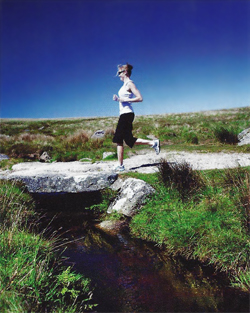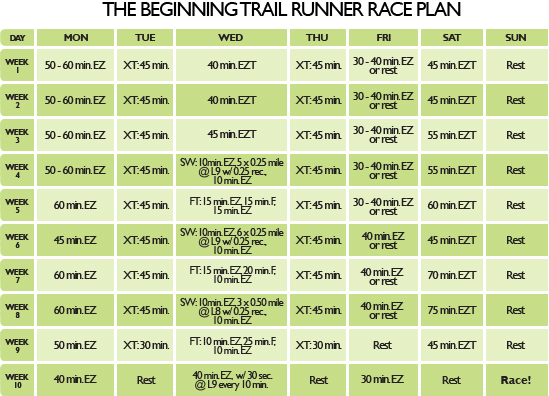Running through pristine forests and up rugged mountains isn’t just for the ultra runner anymore—mere mortals can join in the fun. Use this 10-week training plan to head off road and finish your first trail race.

Trail running offers a fun challenge and is a refreshing way to get outdoors and explore nature. Although your pace may suffer a little off road, every step you take challenges your hips, quadriceps and calves, which helps improve balance, strength and foot turnover. The bonus: Because of the softer terrain, trail running offers a lower risk of injury than running on hard roads or paved paths.
You can easily find a trail to train on at trails.com or americantrails.org, and you can register for races in your neck of the woods at active.com. So, what are you waiting for? Pick a race, find a trail and get started on your off-road journey with this 10-week training program.
Tricks of the Trail
Running off road can be exhausting at first, and it may take you up to twice as long as your normal run, especially in the early stages of training. It’s wise to leave your ego at home, slow your pace and focus on finding a new rhythm. In a matter of weeks, you’ll be running up hills you used to walk, and you’ll develop a sense of being one with the terrain. Here are some tips to help.
Use your arms. Running uphill, you gain more power by pumping your arms vertically from your hips toward your shoulders. Stay balanced by keeping your elbows slightly wider and farther away from your body on the technical and downhill stretches of the trail. Keep your torso tall, shoulders relaxed and chest open to allow your lungs to fully expand and get extra oxygen.
Stay focused. Like downhill skiing or mountain biking, you’ll find a safe line down technical terrain by looking a few steps in front of you. It can be tempting to look around you or at your watch, but do so only when the trail is flat and predictable or while taking walk breaks.
Develop strength. In your weekly training, it’s important to include exercises to build balance, strength and agility so you’re ready to tackle obstacles (tree roots, sand, uneven terrain) on the trail. Add these into your strength program:
Single Leg Balance: Stand on one foot for about 35 to 45 seconds, keeping your torso tall and hips under the shoulders. Repeat on each leg four times. When this gets easy, hold light dumbbells and add a running arm motion while you balance on one leg. To progress even further, stand barefoot on a folded towel, balance disk or gym mat for 60 seconds.
Single Leg Lunge: With your feet hip-width apart, take an exaggerated step forward with your right leg onto a pillow balance pad or disk. Keeping your core in good alignment, bend the front knee 90 degrees until the thigh is parallel with the floor. Hold for five to 10 seconds. Push through the heel to straighten the leg. Repeat for 12 to 15 repetitions. Then switch legs. When this gets easy, alternate legs after each repetition.
Change gears. Adjust your pace (walk if you need to) according to the terrain, and maintain a consistent effort level as you climb uphill. Practice your downhill technique by lengthening your stride, keeping your weight slightly forward and arms wide. Think of taking quick steps, never landing fully on each foot. When in doubt, walk. Running over downed trees or through mud and sand takes some time getting used to, and it’s best to progress slowly. Tackling obstacles will get easier as your body gets stronger and more seasoned on trails.
Dress right. Trail running shoes like Adidas Adizero XT ($80, adidas.com) or La Sportiva Fireblade ($95, sportiva.com) are lower profile than regular running shoes, and provide more lateral support for your ankles and feet. The rugged tread offers better traction on muddy, wet trails. They should fit snug in the heel, but have room in the toe-box. Wear layers, sunglasses, bug spray with sun protection and a running hat. A hydration backpack can carry a map, cell phone and water bladder comfortably.
Training to Race
In order to race well on the trails, you have to train on the trails. Aim to run at least twice a week on trails (50 percent of your runs) and the rest on roads. Balancing the two will allow you to adapt to the new demands of the trail while maintaining the ability to run on harder surfaces without soreness. Start with training on groomed trails, and progress to rugged trails once you have more off-road miles under your belt.
The beginning trail running plan is geared for those who want to train for their first 5k or 10k trail race and are currently running at least four to six miles, three times per week. The plan progresses gradually over 10 weeks and includes two easy runs, one long trail run, one speed run on roads or trails, and two cross-training workouts each week. Remember, your pace will be much slower on trails, so use your effort level to guide you, not your watch.

Tips for Race Day Success
Go with what you know. Wear the trail shoes you’ve trained in, and if the race is 8k or longer, bring your own hydration system. Some races offer aid stations on the course, but many don’t.
Start slow and find your natural place in the pack. The start of a trail race is a bit like the swim start in a triathlon, where everyone merges onto a narrow trail. Trying to dart ahead of the crowd early can leave you lifeless in the later stages of the race. Race like the tortoise, not the hare, and conserve your energy for the last quarter of the race when everyone else will be fatigued.
Play mind games. In the later stages of the race when you are tired, pick out a runner ahead and set a goal to pass them on a downhill or flat stage of the race. It’s a fun way to keep your mind actively engaged and finish strong.
Relax and have fun. Trail running is a great way to mix up your regular running routine and explore nature’s playground. Enjoy the race!


